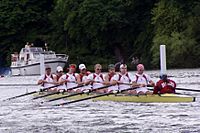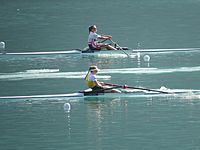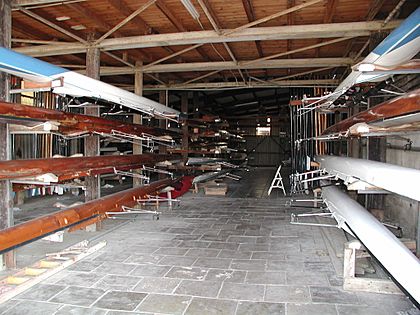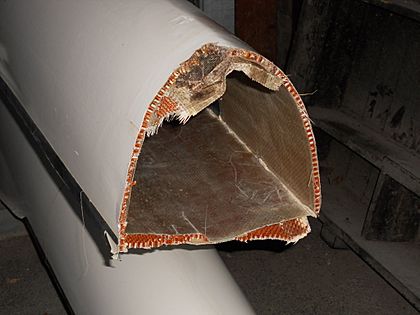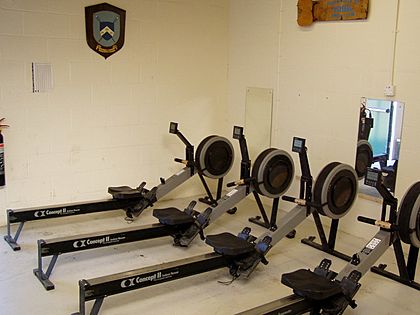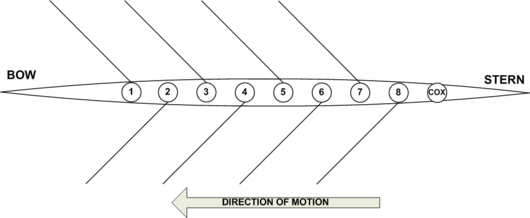Rowing (sport) facts for kids
|
An eight (top) and single sculls (bottom)
|
|
| Highest governing body | World Rowing Federation |
|---|---|
| First modern-day competition | 1715 |
| Characteristics | |
| Contact | No |
| Team members | 1, 2, 3, 4, 5 or 9 (depending on boat class and whether there is a coxswain) |
| Mixed-sex | Separate competitions |
| Type | Water sport, outdoor |
| Equipment | Racing shell, oars |
| Venue | River, artificial lake, canal, ocean |
| Glossary | Glossary of rowing terms |
| Presence | |
| Olympic | since 1900 (men only); since 1976 (both men and women) |
| Paralympic | since 2008 |
| World Games | Indoor: 2017 |
Rowing is an exciting sport where teams or individuals race boats using special oars. Unlike paddling sports (like canoeing), rowing oars are fixed to the boat with 'oarlocks'. This means the oars stay attached to the boat.
Rowing has two main styles: sculling and sweep rowing. In sculling, each rower holds two oars, one in each hand. In sweep rowing, each rower holds one oar with both hands. Boats can hold from one person (a single scull) up to eight rowers and a coxswain (called an eight). Most big races happen on calm water courses that are 2 kilometres (1.2 mi) long. These courses have lanes marked by buoys.
Competitive rowing started in the early 1600s. Professional watermen (people who worked on boats) raced on the River Thames in London, England. Later, in the late 1700s, "boat clubs" formed at British schools. Colleges like Oxford and Cambridge also started clubs in the 1800s. The first American college rowing club began at Yale University in 1843.
Rowing is one of the oldest Olympic sports. Men have competed since the 1900 Summer Olympics. Women's rowing was added in 1976. Today, there are fourteen boat types that race at the Olympics. The World Rowing Federation also holds yearly World Rowing Championships with many different boat classes. Over 150 countries now have rowing teams.
Contents
A Look Back: History of Rowing


Rowing has a very long history! An ancient Egyptian writing from 1430 BC talks about a warrior named Amenhotep II who was famous for his rowing skills. In a famous Roman poem called the Aeneid, Virgil writes about rowing races held to honor a father. In the 1200s, festivals in Venice called regata included boat races.
The first "modern" rowing races started in the United Kingdom. Professional watermen who used boats as taxis on the River Thames in London would race each other. Often, prizes were given by rich companies or people living by the river. The oldest race that still happens today is Doggett's Coat and Badge. It started in 1715 and is held every year from London Bridge to Chelsea. These races became very popular in the 1800s. In America, the first known race was in New York in 1756.
Amateur (non-professional) rowing started in England in the late 1700s. Early boat clubs were at Eton College and Westminster School in the 1790s. At the University of Oxford, the first races were in 1815. The famous The Boat Race between Oxford and Cambridge Universities started in 1829. This race led to the creation of the Henley Royal Regatta in 1839.
The Leander Club, founded in 1818, is the world's oldest public rowing club. In the U.S., the Narragansett Boat Club started in 1838. The Harvard–Yale Regatta is the oldest college sports event in the United States, starting in 1852.

The Schuylkill Navy is a group of amateur rowing clubs in Philadelphia. It was founded in 1858 and is the oldest amateur sports group in the United States. Its clubs are mostly on the historic Boathouse Row along the Schuylkill River. This group helped make rowing a sport for amateurs, not just professionals.
The World Rowing Federation (called FISA before) was created in 1892. It is the oldest international sports group in the Olympic world. FISA held the first European Rowing Championships in 1893 and the first World Rowing Championships in 1962.
Women in Rowing
Women row in all types of boats, from single sculls to eights. They compete at all ages and skill levels, from juniors to elite athletes. Usually, men and women compete in separate teams, but sometimes mixed teams race too. The world's first women's rowing team started in 1896 at the Furnivall Sculling Club in London.
The first international races for women were the 1954 European Rowing Championships. When women's rowing was added to the rowing at the 1976 Summer Olympics in Montreal, it helped the sport grow a lot. At the Rowing at the 2012 Summer Olympics in London, there were six events for women. In the U.S., college rowing for women is a big sport, partly because of a law called Title IX.
Countries like Romania, Russia, and Bulgaria have traditionally been very strong in women's rowing. But other countries like Germany, Canada, the Netherlands, Great Britain, New Zealand, and the United States also have very competitive teams.
How to Row: Technique
When you row, you sit facing the back of the boat (the stern). You use the oars, which are held in place by oarlocks, to push the boat forward (towards the bow). Remember, rowing is different from paddling because the oar is attached to the boat.
A rowing stroke has two main parts:
- The catch: This is when you put the oar blade into the water.
- The extraction (or finish): This is when you take the oar blade out of the water.
After the blade is in the water at the catch, you push on the oar. This is called the drive phase. You push your seat towards the front of the boat by straightening your legs. This pushes the boat through the water. As your legs straighten, you lean your body forward and pull the oars towards your chest.
When the stroke finishes, you slightly drop your hands. This helps lift the oar out of the water smoothly.
The recovery phase happens after the drive. In this phase, you lift the blade out of the water and quickly turn the oar so the blade is flat (parallel to the water). This is called feathering the blade. At the same time, you push the oar handle away from your chest. After feathering and extending your arms, you lean your body forward. Once your hands are past your knees, you bend your legs. This moves your seat back towards the stern. This leg bending happens slowly, giving you a moment to rest. This also lets the boat glide smoothly through the water, which is called run.
A smooth recovery helps keep the boat moving fast. Near the end of the recovery, you turn the blade to be straight up and down (perpendicular to the water) and get ready for the next stroke.
Types of Boats
There are two main ways to row, or "disciplines":
- Sweep rowing: Each rower has one oar, held with both hands. There are usually an even number of rowers: two, four, or eight. Each rower's oar goes out to their left (port) or right (starboard) side of the boat.
- Sculling: Each rower has two oars (called sculls), one in each hand. Sculling boats usually don't have a coxswain. Common sculling boats are quads (four rowers), doubles (two rowers), or singles (one rower).
Boats are classified by:
- The number of rowers: 1, 2, 4, or 8.
- Whether there is a coxswain (a person who steers and guides the crew). Boats without a coxswain are called "coxless" or "straight."
Here are the common boat types:
Sculling Boats:
| Boat Abbreviation | Boat Name |
|---|---|
| 1x | Single sculls (or "single") |
| 2x | Double sculls |
| 4x | Coxless quadruple sculls (or "quad") |
| 4x+ | Coxed quadruple sculls (often for younger rowers) |
| 8x+ | Octuple sculls (always coxed, usually for juniors) |
Sweep Boats:
| Boat Abbreviation | Boat Name |
|---|---|
| 2- | Coxless pair (or "straight pair") |
| 2+ | Coxed pair |
| 4- | Coxless four (or "straight four") |
| 4+ | Coxed four |
| 8+ | Eight (always coxed) |
Rowing Gear: Equipment
Racing Shells
Racing boats are often called shells. They are long, narrow, and rounded at the bottom to move easily through the water. They usually have a fin at the back to help them stay straight and stable.
Shells used to be made from wood. Now, they are almost always made from light, strong materials like carbon-fiber reinforced plastic. This makes them strong and light. Rules set minimum weights for each boat type. This stops teams from gaining an unfair advantage by using super expensive materials.
Smaller sculling boats are usually steered by the rowers. Larger boats often have a rudder controlled by the coxswain, or by one of the rowers using a cable.
Sculling boats apply force evenly to both sides, while sweep boats apply force unevenly. This means sweep boats need to be stronger and are usually heavier. Sculling is also more efficient because the forces are balanced.
Many adjustments can be made to the boat and oars to fit the crew. These adjustments are called the boat's rigging.
Oars
Oars are used to push the boat. They are long poles with a flat end called the blade. Sculling oars are about 2.5 to 3 meters long. Sweep oars are longer, about 3.4 to 3.6 meters. Old oars were made of wood, but modern ones are made from strong carbon fiber.
A sweep oar is often called a blade. A sculling oar is called a scull. Sculling oars are shorter and have smaller blades than sweep oars. However, the total blade area of two sculling oars is larger than one sweep oar. This means a sculler works against more water. They can do this because the sculling motion is more balanced for the body.
The spoon (blade) of oars is usually painted with the club's colors. This helps identify boats from far away. Just like sports teams have logos on their jerseys, rowing clubs have special painted blades.
Training Equipment
Indoor rowing helps athletes train their technique and strength. It uses machines that mimic rowing, providing resistance. Indoor rowing is useful when there's no water nearby or when the weather is bad.
A rowing tank is an indoor pool that tries to feel like open water. It's used for training when it's cold or stormy outside.
Ergometer rowing machines (called ergs) copy the rowing action. They let you train on land and measure your fitness. Ergs don't perfectly copy the feeling of being on water, like balancing the boat. So, erg scores are not the only way to pick a crew. But they are great for a tough workout! Indoor rowing has even become a sport itself, with competitions like the CRASH-B Sprints.
Race Formats
Rowing races are called "regattas". The two most common types are side-by-side races and head races.
Side-by-Side Races
Most races in spring and summer are side-by-side, or sprint, races. All boats start at the same time from a stop. The first boat to cross the finish line wins. Races usually have two to eight boats.
The standard race length for the Olympics and World Rowing Championships is 2 kilometres (1.2 mi). Many high school races in the U.S. are 1.5 kilometres (0.93 mi). Older rowers (Masters) often race 1,000 meters. Some races are very short "dashes" (500 metres (1,600 ft)) or very long, like the 6.8 kilometres (4.2 mi) The Boat Race.
Big competitions usually have several rounds. The fastest boats move on to the next round. Boats that lose might get a second chance in a "repechage" race. At the Henley Royal Regatta, two crews race side-by-side in each round. It's a simple knock-out tournament.
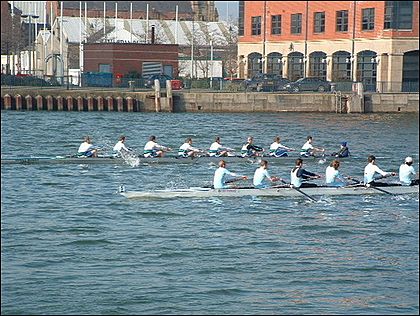
Head Races
Head races are like time trials. They happen from autumn to early spring. Boats start one by one, usually 10-20 seconds apart. They are timed over a set distance. Head courses are usually 2,000 metres (6,600 ft) to 12,000 metres (39,000 ft) long.
The oldest and most famous head race is the Head of the River Race, started in 1926 on the River Thames in London. Head racing came to the United States in the 1950s. The Head of the Charles Regatta in Boston is now the largest rowing event in the world. These races are called Head Races because the fastest crew is named "Head of the River."
Time trials are also used to decide who gets to compete in events with limited spots.
Other Race Formats
A bumps race is a multi-day race. Crews start lined up along the river at set distances. They all start at the same time and try to catch the boat in front of them. If a crew catches or touches the boat ahead, it's called a bump. The next day, the bumping crew starts ahead of the bumped crew. This can cause damage to boats! To avoid damage, the coxswain of the boat being bumped might give up before contact. Oxford and Cambridge Universities have bumps races for their colleges twice a year.
The stake format was used in early American races. Boats race to a marker (a stake or buoy) and then turn around and race back. The 180-degree turn needs good steering. Spectators like these races because they can see both the start and finish. Usually, only two boats race at a time to avoid crashes.
Boat Positions
In boats with more than one rower, positions are numbered from the front (bow) to the back (stern). The rower at the very front is called the bowman or 'bow'. The rower closest to the stern is called the 'strokeman' or 'stroke'.
In an 8-person boat, the two rowers at the back (stern pair) set the speed and rhythm for everyone else. The middle four rowers (sometimes called the "engine room") are usually the strongest. The two rowers at the front (bow pair) are often the most skilled at balancing the boat and helping it steer straight.
Coxswain
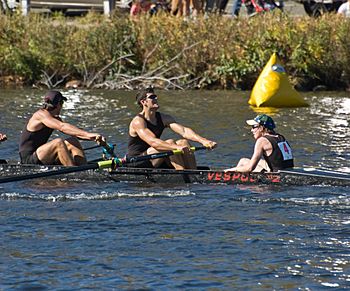
The coxswain (or just cox) sits in the boat facing the bow. Their job is to steer the boat and tell the rowers what to do. They use a special device called a cox box and speakers to talk to the crew. Coxswains usually sit at the back of the boat. But in some boats, like bowloaders, the coxswain lies down in the front.
It's good for a coxswain to be light, as this makes the boat faster. In many races, there's a minimum weight for the coxswain (like 55 kilograms (121 lb)). If a coxswain is too light, they might have to carry extra weights, like sandbags, in the boat.
Athlete Categories
Age Groups
The World Rowing Federation has different age groups:
- Under 19: Athletes aged 18 or younger by the end of the year. They compete in the World Rowing Junior Championships.
- Under 23: Athletes aged 22 or younger. They have their own World Rowing U23 Championships.
- Senior: Events open to rowers of any age.
- Masters: Athletes aged 27 and older. They have the World Rowing Masters Regatta with many age subcategories.
Weight Classes
Lightweight boat classes have weight limits for the rowers. This category was created to encourage more people to join the sport, especially those who are not as tall or big. Lightweight events started at the World Championships in 1974 for men and 1985 for women. They were added to the Olympics in 1996.
World Rowing lightweight limits are:
- Men: Crew average 70 kilograms (150 lb) – no rower over 72.5 kilograms (160 lb).
- Women: Crew average 57 kilograms (126 lb) – no rower over 59 kilograms (130 lb).
In U.S. college rowing, lightweight limits can be different. For junior rowers in the U.S., the limit for men is 150.0 pounds (68.0 kg) and for women is 130.0 pounds (59.0 kg).
Pararowing
Adaptive rowing is for athletes with physical disabilities. There are different boat classes for adaptive rowers based on their abilities. These events are held at the World Rowing Championships and the 2008 Summer Paralympics.
Who Runs Rowing?
The World Rowing Federation (FISA) is the main international group that governs rowing. It organizes the World Rowing Championships and other big international races. World Rowing also oversees rowing at the Olympics.
More than 155 countries have their own national rowing groups that are part of the World Rowing Federation.
Big International Races
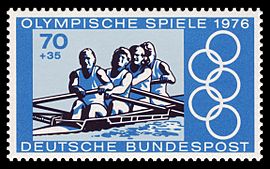
The Olympic Games happen every four years. Only certain boat classes race there (14 in total):
- Men: quad scull, double scull, single scull, eight, coxless four, and coxless pair.
- Lightweight Men: double scull.
- Women: quad scull, double scull, single scull, eight, coxless four, and coxless pair.
- Lightweight Women: double scull.
At the end of each year, the World Rowing Federation holds the World Rowing Championships. These championships have events in 22 different boat classes. The Olympic classes are usually seen as the most important events. In 2017, World Rowing decided to make the Olympic program equal for men and women. So, the lightweight men's coxless four event was replaced by the women's heavyweight coxless four. In Olympic years, only non-Olympic boats compete at the World Championships.
Staying Healthy: Fitness and Health
Rowing is one of the few sports that uses almost all your major muscle groups. This includes your quads (thighs), biceps and triceps (arms), lats (back), glutes (butt), and abdominal muscles (stomach). Rowing also makes your heart and muscular strength stronger. Good rowers are often tall and strong. Taller athletes have longer limbs, which gives them more power on the oar. In boats with more than one person, the lightest rower usually sits in the bow seat.
Rowing is a "low-impact" sport. This means it's gentle on your joints, so twist and sprain injuries are rare. However, the repeated motion can put stress on your knees, spine, and forearm tendons. Swelling in these areas is the most common rowing injury. If you row with bad technique, especially with a curved back, you might get back pain. Blisters on your hands are also very common, especially when you start rowing. This is because every stroke puts pressure on your hands. Rowing often makes your hands tougher and builds calluses.
See also
 In Spanish: Remo (deporte) para niños
In Spanish: Remo (deporte) para niños


